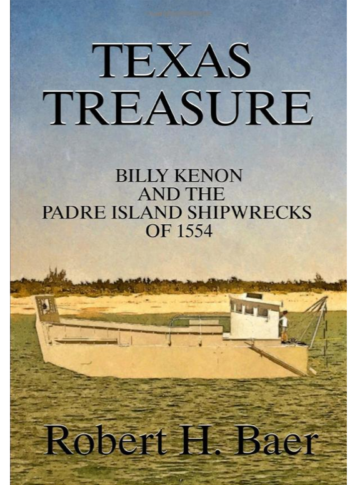
Texas Treasure
Billy Kenon and The Padre Island Shipwrecks of 1554
In 1554 a fleet of Spanish ships, laden with treasures from the New World departed from Vera Cruz in Mexico, bound for Havana. For reasons yet unknown, at least three of the vessels were wrecked on the coast of present-day Texas at Padre Island, not far north of the Rio Grande where their remains languished for centuries. Treasure hunters armed with metal detectors began finding Spanish coins on Padre Island in the 1960s. Billy Kenon, a local salvage master teamed up with the Znika brothers from Indiana and formed the Platoro Group with an eye toward finding the remains of the ships and their treasure cargo. This is the story of Billy Kenon’s successful salvage of one of those ships, and the 20 year battle he endured with Texas authorities over rights to the treasure he and the Platoro Group recovered in the turbid waters of the Gulf of Mexico. Bob Baer gives Billy Kenon a voice, drawing attention to the treachery of Texas bureaucrats, and the true significance of the Platoro Group’s discoveries.
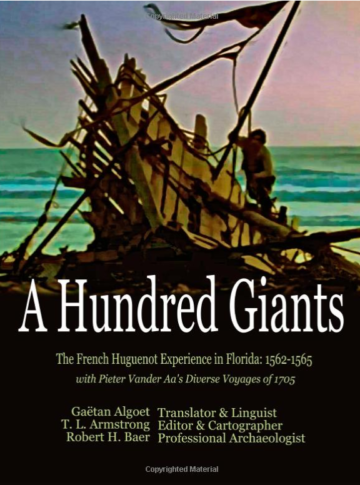
A Hundred Giants:
The French Huguenot Experience in Florida: 1562-1565
The first settlement of Europeans in Florida occurred in 1564 in the vicinity of Jacksonville. French Huguenots attempted a foothold there and lasted a year before being wiped out by the Spanish. As the struggle between the French and Spanish developed, French forces were shipwrecked along the Florida coast and executed by the Spaniards in the vicinity of Matanzas Inlet. In 2008 the authors began translating a Dutch manuscript published by Pieter Vander Aa, circa 1705, which was a collection of several French memoirs dealing with their settlement at Fort Caroline and subsequent conflicts with Spanish forces. The Vander Aa manuscript, previously unseen as an English publication, is used to drive on the investigation of new evidence found along the shore of Florida indicating where the Huguenots were killed and where at least one of their ships was wrecked. The book contains an exact reproduction of the Vander Aa manuscript, photos of artifacts supporting the new evidence, and more than twenty maps illustrating the subject locations. The French saga in Florida, albeit one thoroughly studied for more than a century, is presented here with fresh overview and comparative citations from previous scholars on the subject. More than 60 color photos and more than 20 color maps. Includes 66 image pages of the original Vander Aa manuscript. Dozens of artifact and coin photos.
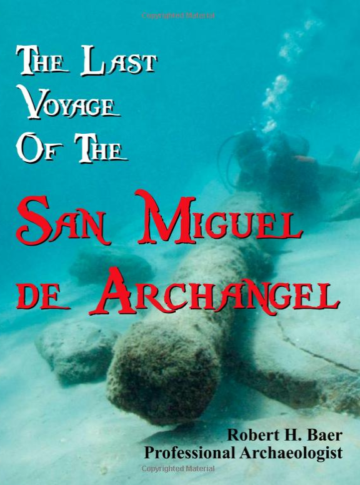
The Last Voyage of the San Miguel de Archangel
Written from the perspective of the project archaeologist, this is the story of a remarkable, albeit accidental, discovery of a Spanish vessel on a secret mission carrying a unique cargo bound from Peru to the King of Spain, circa 1659. The San Miguel de Archangel carried a sample of the vaunted 'Star of Lima' coinage, minted illegally by the Count Alba de Liste. The ship wrecked with little note in the annals of Florida's history... until now.
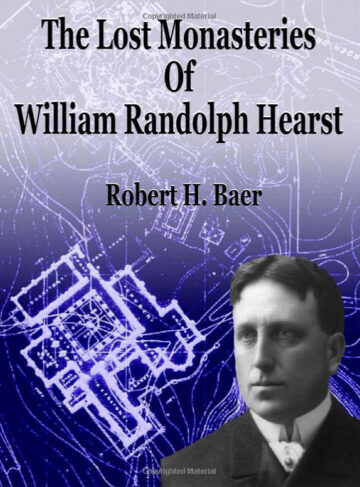
The Lost Monasteries of William Randolph Hearst
Between the years 1925 and 1931 the publishing tycoon, William Randolph Hearst acquired six Medieval Period structures in the United Kingdom and Spain. Hearst dismantled all, or portions, of these buildings, with the intention of rebuilding some, and using others as ‘fabric’ for other construction projects in the United States, most notably, Hearst Castle at San Simeon, California and another residence, St. Donats’s Castle in Wales. The Lost Monasteries of William Randolph Hearst is the story of Dr. Robert Baer’s quest to document this little known, and little researched period in the life of WRH, within the wider context of Hearst’s life as a builder and collector.
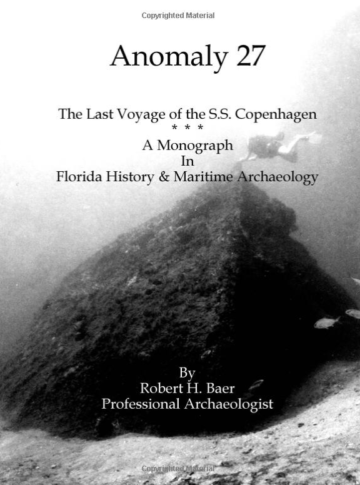
Anomaly 27:
The Last Voyage of the S.S. Copenhagen
Here's the story of Anomaly 27, a section of mystery wreckage which lays more than 2000 feet from the hulk of the S.S. Copenhagen, a vessel which grounded near Pompano Beach, Florida at the turn of the last century. A professional archaeologist, Dr. Robert Baer describes the anomaly, how it was located, and, finally, how the anomaly is proven to be the missing bow section of the S.S. Copenhagen. The author explains the details of the discovery and the methods used to confirm the identity of the wreckage. This is a story of modern-day exploration at its finest. A great read for wreck divers and academics alike! Fully illustrated with magnetometric charts, wreck site maps, bathymetric charts, contemporary underwater photos as well as classic photos of the Copenhagen as she sits stranded just after the wreck event. 90 pages, B&W, with an index containing more than 500 citations. Reference listings along with figure citations in classic monograph style.
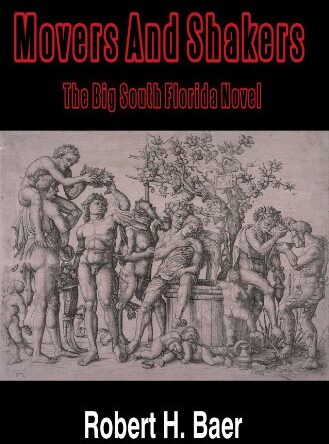
Movers and Shakers
South Florida in the late 1960’s and early 1970’s is in turmoil. South Beach, now a ‘Mecca’ for the “Rich and Famous’ is a ‘ghetto’ of retirement hotels and cheap restaurants; the Cuban Revolution, and waves of immigration, have changed the culture of Miami forever. Dade County police detective, Captain Eduardo Gonzalez is challenged by a series of gruesome ‘armed home invasion’ murders, and the political pressure is on - there are few leads. Fifty miles north of Miami in ‘trendy’ Palm Beach, art dealer Peter Cooper has been talked into making the presentation of a ‘pricy’ painting, by Georgia O’Keefe, at a birthday party, hosted by a nouveau riche couple, Bruce and Rebecca Hirsch. But all is not well, the armed home invasion team of a rogue government contract killer, Monkeyto, and his buddies, Paco and Chee Chee, have targeted Bruce and Rebecca, as they have chosen most of their victims, by reading the South Florida ‘Glitter Mags’ and the ‘Social Sections’ of Miami and Palm Beach newspapers.
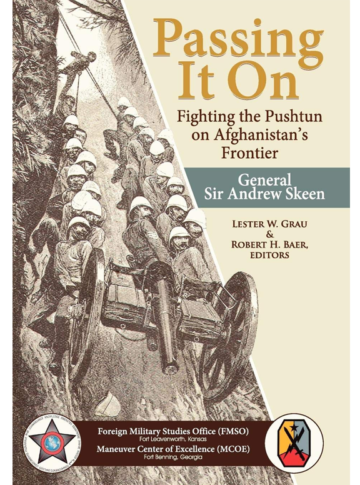
Passing It On:
Fighting the Pashtun on Afghanistan's Frontier Paperback
A Republished and Annotated Edition of "Passing It On: Short Talks on Tribal Fighting on the North-West Frontier of India" with new a Forward and Lessons Learned. Republished by the Foreign Military Studies Office, Fort Leavenworth, Kansas. Illustrated. From the foreword: "This book, originally published as a guide for British lieutenants and captains, demonstrates that improvements in technology-much of it available to both sides - have had only a modest impact on infantry fighting in this rugged terrain. However, it also demonstrates that the key to enhancing basic infantry effectiveness is using the terrain effectively, maintaining force security and understanding the mountain people. General Sir Andrew Skeen spent decades dealing with this frontier. His combat experience in the Afghanistan frontier region was extensive, but he also saw action against the Boxers in China, in Somaliland, Gallipoli and the trenches of the Western Front in World War I. His final field posting was as the Chief of the General Staff of the Army of India. "Passing it on" is about passing on his experience in this turbulent region to the lieutenants and captains who were then dealing with the problems of mountain combat against Pushtun tribesmen. His advice is still relevant to what our soldiers are facing today. The mission of the Foreign Military Studies Office is to esearch and present foreign ideas and perspectives to better understand present and future problems. Occasionally we visit the past to find those ideas and perspectives. This 1932 book is not so much a step backwards as the (re)discovery of a useful map for now and the future. We hope it will be of value to our readers".